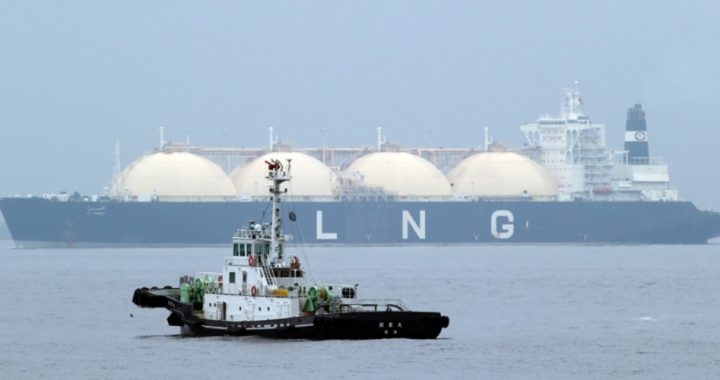
LNG (liquefied natural gas) coming from the United States is already changing the energy equation in Europe and is likely to upset its political equation as well.
When the Independence, a floating gas terminal, arrived at the port city of Klaipeda, Lithuania, in October, 2014, it was met with parades, military salutes, and crowds waving Lithuanian flags. At the welcoming ceremony President Dalia Grybauskaite exclaimed: “Nobody else, from now on, will be able to dictate to us the price of gas, or to buy our political will.”
Within a year, imports of Norwegian LNG reduced Russia’s monopoly on natural gas to less than 80 percent, forcing Gazprom, Russia’s natural gas company, to reduce its prices to Lithuania by 23 percent.
Earlier this week, the first LNG tanker left a Louisiana port headed for Europe, opening wider the challenge to Gazprom and Putin’s Russia. For years Russia has bullied its European customers, many of whom were part of the old USSR, into accepting not only higher than market prices but political pressure as well.
At the moment, Gazprom supplies 90 percent of Bulgaria’s natural gas, half of Germany’s and a third of Italy’s. Overall Gazprom supplies a third of all of Europe’s natural gas needs.
Gazprom has a long history of using its dominant position to bludgeon its customers into accepting higher and higher natural gas prices. In January 2006, at the height of the Russia-Ukraine gas dispute, Gazprom abruptly ceased supplying Ukraine with natural gas. In the dead of winter, homes went cold and industries shut down, forcing Ukraine to increase its payments to Gazprom in order to get the Russian bully to turn the gas back on.
In April 2006, Gazprom told Belarus it would be tripling its price of natural gas at the end of the year. When Belarus balked, the bully threatened, again in the dead of winter, to shut off the gas unless the country agreed to pay four times what it was previously paying. Belarus threatened to deny Gazprom access to its vast network of pipelines unless prices were reduced. The final agreement forced Belarus to pay twice its previous price to get its gas turned back on.
In April 2014, Gazprom once again stiff-armed Ukraine, increasing its natural gas prices by 50 percent, forcing Ukraine to run up more than a billion-dollar bill owed to Gazprom.
Russia has always been a bully, using Gazprom as one of its primary levers. Rokas Masiulis, Lithuania’s energy minister said, “In Russia, gas always goes together with politics. Russia is extremely aggressive in gas pricing and the arrival of USLNG will change that.”
Russia has seen the threat coming for years and has covertly funded environmentalists’ demonstrations against shale gas development in countries on its borders to help maintain their dependence on Mother Russia’s gas. Jaroslav Neverovic, Lithuania’s energy minister from 2012 to 2014, said that Gazprom would imperially announce a price increase for its natural gas and the board running the country’s gas transmission company, Lietuvos Dujos, had no choice but to rubber stamp its approval. Neverovic told the Wall Street Journal that the announcement was always made on New Year’s Eve, with the threat of turning off the gas during the coldest days of the winter.
In 2008, when Gazprom once again tried to strong-arm Lithuania into accepting another price hike, the country began negotiations to lease the Independence, the floating gas terminal, from a Norwegian company.
Russia will not leave the field without a fight. Gazprom controls nearly a fifth of the world’s known and recoverable natural gas reserves along with a spaghetti-like network of pipelines feeding it to its European customers. It costs Gazprom less to ship gas by pipe than it will for the United States to ship it by tanker. Although natural gas prices in the United States are below $2 per million BTUs (MMBtu), gas delivered to European gas terminals will cost an estimated $3.60 MMBtu. At present that would still be below the $4.60 MMBtu that Gazprom is charging, but that could change. As Trevor Sikorski of Energy Aspects, a London-based energy consulting company, said, “If Russia wanted to chase out the U.S., they could supply gas at probably $2 in a price war.”
Naturally Gazprom denies any such intent, according to the company’s deputy chairman Alexander Medvedev. But they’re watching developments closely as the inevitable attractiveness of being less dependent upon Russia’s Gazprom, not to mention lower prices, draws countries seeking freedom from extortion more and more to U.S. suppliers.
Linas Linkevicius, Lithuania’s foreign minister, put it well: “The less energy leverage Russia has, the more freedom we have.”
Photo of LNG tanker: AP Images
A graduate of an Ivy League school and a former investment advisor, Bob is a regular contributor to The New American magazine and blogs frequently at LightFromTheRight.com, primarily on economics and politics. He can be reached at [email protected].



